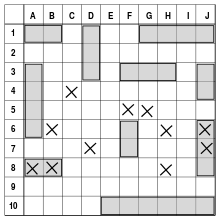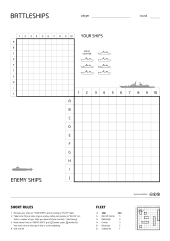Battleship (game)

Battleship (also Battleships or Sea Battle[1]) is a guessing game for two players. It is known worldwide as a pencil and paper game which dates from World War I. It was published by various companies as a pad-and-pencil game in the 1930s, and was released as a plastic board game by Milton Bradley in 1967. The purpose of the game is to destroy the opposing player's battleships.
History
The game of Battleship is thought to have its origins in the French game L'Attaque played during World War I, although parallels have also been drawn to E. I. Horseman's 1890 game Baslinda,[2] and the game is said to have been played by Russian officers before World War I.[3] The first commercial version of the game was Salvo, published in 1931 in the United States by the Starex company. Other versions of the game were printed in the 1930s and 1940s, including the Strathmore Company's Combat: The Battleship Game, Milton Bradley's Broadsides: A Game of Naval Strategy and Maurice L. Freedman's Warfare Naval Combat. Strategy Games Co. produced a version called Wings which pictured planes flying over the Los Angeles Coliseum. All of these early editions of the game consisted of pre-printed pads of paper.[2]

In 1967 Milton Bradley introduced a version of the game that used plastic boards and pegs. The method of play involved using pegboards and miniaturized plastic ships, and was thought of by Ed Hutchins. In 1977, Milton Bradley also released a computerized Electronic Battleship,[4] followed in 1989 by Electronic Talking Battleship.[5] In 2008, an updated version of Battleship was released, using hexagonal tiles. In the updated version, each player's board contains several islands on which "captured man" figurines can be placed. Ships may be placed only around the islands, and only in the player's half of the board. When the movie Battleship was released, the board game reverted to the original 1967 style. The 2008 updated version is still available as Battleship Islands.
Battleship was one of the earliest games to be produced as a computer game, with a version being released for the Z80 Compucolor in 1979.[2][6] Many computer editions of the game have been produced since. In Clubhouse Games for the Nintendo DS, Battleship is known as Grid Attack. It is played on an 8×8 grid, and includes slight variations, such as 4-player gameplay, various ship sizes and shapes, as well as the option to make the ships touch each other. Iterations of Battleship appear as applications on numerous social networking services.
Battleship was also part of Hasbro Family Game Night for the PlayStation 2 and Wii, as well as the Xbox 360 (Xbox Live Arcade). These alter the rules, including the size of the grid (8×12 in the NES version, 8×8 in the Game Boy version), size of ships (it is common to feature a submarine that takes up a single square) and special shot missiles for each ship (for example, in the NES version the cruiser has a 5-shot missile which strikes 5 squares in an X pattern on the grid in one turn. Submarine-tracking sonar and aerial reconnaissance to spot ships are also features).
A minigame version of Battleship was used in the third season of The Hub's Family Game Night, which uses a 5×5 grid and the first team to sink three ships wins the game.
In 2012 the science fiction action movie Battleship was released, which was inspired by the board game.
Description

The game is played on four grids, two for each player. The grids are typically square – usually 10×10 – and the individual squares in the grid are identified by letter and number.[7] On one grid the player arranges ships and records the shots by the opponent. On the other grid the player records their own shots.
Before play begins, each player secretly arranges their ships on their primary grid. Each ship occupies a number of consecutive squares on the grid, arranged either horizontally or vertically. The number of squares for each ship is determined by the type of the ship. The ships cannot overlap (i.e., only one ship can occupy any given square in the grid). The types and numbers of ships allowed are the same for each player. These may vary depending on the rules.
The 1990 Milton Bradley version of the rules specify the following ships:[8]
| # | Class of ship | Size |
|---|---|---|
| 1 | Carrier | 5 |
| 2 | Battleship | 4 |
| 3 | Cruiser | 3 |
| 4 | Submarine | 3 |
| 5 | Destroyer | 2 |
After the ships have been positioned, the game proceeds in a series of rounds. In each round, each player takes a turn to announce a target square in the opponent's grid which is to be shot at. The opponent announces whether or not the square is occupied by a ship, and if it is a "miss", the player marks their primary grid with a white peg; if a "hit" they mark this on their own primary grid with a red peg. The attacking player notes the hit or miss on their own "tracking" grid with the appropriate color peg (red for "hit", white for "miss"), in order to build up a picture of the opponent's fleet. After the player gets a hit the player continues shooting until the player gets a miss.
When all of the squares of a ship have been hit, the ship is sunk, and the ship's owner announces this (e.g. "You sank my battleship!"). If all of a player's ships have been sunk, the game is over and their opponent wins.
Variations
- In the 1931 Salvo edition of the game, players target a specified number of squares at one time, and all of the squares are attacked simultaneously. A player may initially target six squares per turn, and this is decreased as ships are lost.[3] In other variants of this mechanic, the number of shots a player is allowed to fire each turn may either be fixed at five for the whole game, be equal to the number of unsunk ships belonging to the player, or be equal to the size of the player's largest undamaged ship.[2] The receiving player may either call the result of each shot in turn, or simply announce, say, "two hits and three misses", leaving their opponent to work out the consequences of the salvo.[2] In the modern Milton Bradley rules for Battleship, Salvo is listed as a variation "for more experienced players", with the number of shots being equal to the number of ships that the firing player has remaining.[8]
- One variant allows players to decline to announce that a ship has been sunk, requiring their opponent to take further shots in order to confirm that an area is clear.[2] Another house rule allows a player to move one of their ships to a new, uncalled location every fourth or fifth move.[2]
- A slightly different version of the game is played in India. Instead of announcing whether a shot is a hit or miss immediately, the players simply say how many of their opponent's three shots were hits, and if so on what kind of vessel. This allows for more strategy in game play and loosens the game's dependency on luck. A slightly different recording system is used in this variation as there is a new importance on what turn a player hit something on. The ships themselves are also slightly different: the Indian version uses two submarines (two spaces), two destroyers (three spaces), one battleship (five spaces), and one aircraft carrier (five spaces arranged in a 'T').
- Ship Attack is a development of the game that stresses analytical thought over (relatively) blind guessing. The players use intelligence collecting tools in order to pinpoint the location of each and every vessels in the enemy fleet. A reconnaissance airplane reports sequences of ship parts in a row or column, a satellite image can be taken to count ship parts on a 3×3 square, and a paratrooper can determine if one tile is populated by a ship part or sea. This variation can be played with the same board drawing on the pen and pencil version. Ship Attack rules are a platform to Bimaru-style puzzles, in which one is presented with a minimal intelligence report required to decipher an entire board.
- The Japanese variation of the game differs in several key aspects. It uses a 5×5 grid, on which each ship takes up one space. Each player has 3 ships, distinguished only by the number of hits they can sustain before sinking. Ships may move in orthogonal directions in lieu of firing, but the type of ship, distance, and direction of the move must be announced to one's opponent. Ships may only fire on neighbouring squares, including diagonals, but a near-miss (when a square next to one's own ship is hit) must be declared as such. Regional variations include rules for multiple shots, limited ammunition, no consecutive moves, and friendly fire, among others. With the increasing popularity of the international version of the game, the Japanese version has apparently lapsed into comparative obscurity even in its native country.
- The customary Russian version known as Морской Бой ("Sea Battle") is comparatively simple and is mostly pen-and-paper. It is almost always played on a 10×10 grid (with Cyrillic lettering, with letters «й» and «ё» normally omitted). Depending on the rules, a player may or may not take another shot on the same turn if an enemy ship is hit. Ships cannot occupy squares next to each other, horizontally, vertically or diagonally. Also, the set of ships is noticeably different (see table below). The alternate designations are based on dated distinctions of ship classes, namely the number of gun decks for Age of Sail and number of funnels for earlier steam-powered ships. Note the matching size and number of decks/funnels.
- The Slovenian version from 2001 takes the game into 3D space, yet it maintains the pen&paper simple format. The 3D grid is 5×5×5 space and each ship must be placed with the three coordinates. No diagonal placing is allowed. The game was developed by Blaž Branc and Matej Avsenak.
Type of ship Size Number per player battleship (Russian: линкор)/four-decker (Russian: четырёхпалубник)/four-funnel (Russian: четырёхтрубный) 4 1 cruiser (Russian: крейсер)/three-decker (Russian: трёхпалубник)/three-funnel (Russian: трёхтрубный) 3 2 destroyer (Russian: эсминец)/two-decker (Russian: двухпалубник)/two-funnel (Russian: двухтрубный) 2 3 submarine (Russian: подводная лодка)/single-decker (Russian: однопалубник)/single-funnel (Russian: однотрубный) 1 4
See also
- Battleship (puzzle)
- Battleship (1993 video game)
- Mugwump, a 1973 computer game
- BattleFleet (game series)
- Electronic Battleship: Advanced Mission
- Navy Blue series
- Battleship (film)
References
- ↑ "Play School Age: Sea Battle a Free Game at Fupa Games". Fupa.com. Retrieved 4 December 2012.
- 1 2 3 4 5 6 7 Hinebaugh, Jeffrey P. (2009). A Board Game Education. R&L Education. ISBN 9781607092605.
- 1 2 "Salvo Is New Game With a Nautical Air". The Milwaukee Journal. 1 July 1931. Retrieved 18 February 2013.
- ↑ boardgamegeek.com
- ↑ boardgamegeek.com
- ↑ http://titan.apiit.edu.my/pagol/projectinfo.asp?txtID=TP010249[]
- ↑ Salvo – Battleships – Complete Rules – Paper and Pencil Game
- 1 2 "Battleship Rules" (PDF). Hasbro. Retrieved 18 February 2013.
External links
| Wikimedia Commons has media related to Battleship (game). |
- Battleship Official Hasbro Rules – Rulebook insert for Battleship (2002 version)
- Battleship at BoardGameGeek